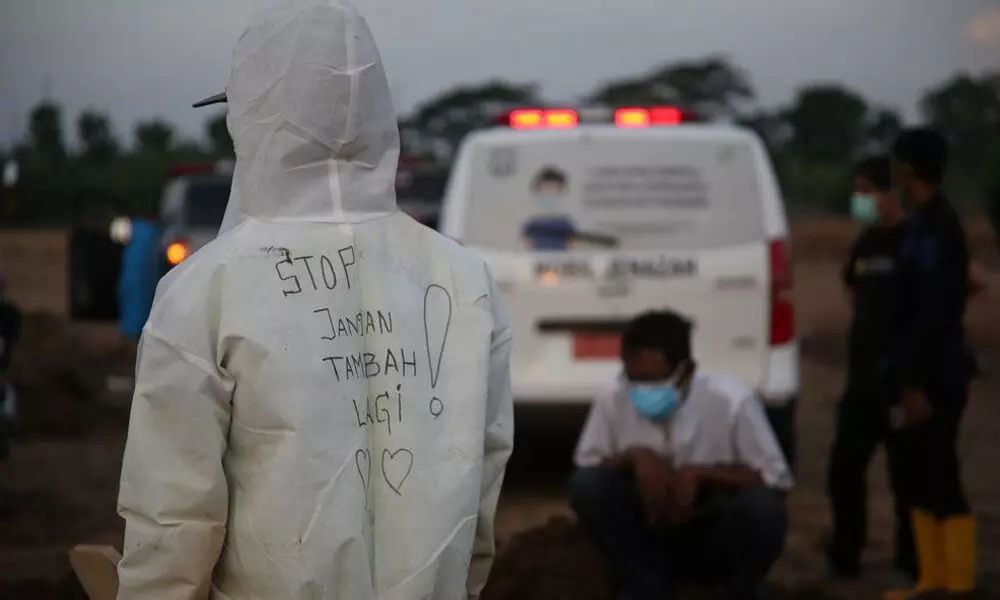What does 8% growth mean when thousands are still dying?
On the books, Asia is poised for an economic rebound. Yet the coronavirus is still raging in countries such as Indonesia, and vast populations are getting left behind
image for illustrative purpose

With about 60% of trade occurring among neighbours, Asia is too interconnected to celebrate isolated Covid victories. A trip by boat or bridge, once allowed, will quickly tell you what the rosy regional projections fail to capture
A tidy financial center of 5.7 million people is gradually preparing for life after the pandemic, as vaccination rates increase, social distancing measures ease and residents once again dare to daydream about leisure travel. A short ferry ride away, a sprawling archipelago with a population of 270 million is struggling to get oxygen, daily Covid cases are north of 20,000 and the death toll exceeds 60,000. The divergent fates of Singapore and Indonesia - and, indeed, many other countries throughout Asia - demonstrate that any economic recovery in this region will risk leaving hundreds of millions of people behind.
The International Monetary Fund (IMF) projects Asia will grow 7.6 per cent this year, boosted by prosperous economies like South Korea, Taiwan, Hong Kong and Singapore, along with the factory and export powerhouse of China. Places such as Indonesia, the Philippines and Malaysia, by contrast, will be hampered by their persistent failure to contain the disease. Posting a positive number on the ledger won't capture the deep hole from which the worst-hit countries have to climb.
Indonesia is now ground zero for Covid in Southeast Asia. The hospitalization rate for patients has exceeded 90 per cent in Jakarta, its capital, while tents have been set up outside hospitals and apartments have been converted into isolation units. Last week, President Joko Widodo slapped strict curbs on Java and Bali, islands that account for more than half of the country's trillion-dollar economy, just as the latter had been preparing to welcome international visitors. Jokowi long resisted large-scale lockdowns in favor of more localized measures. He has since recalibrated as deaths rose to a record and infections soared. Officials warned the spike may continue.
Indonesia's response to the virus has been underwhelming from the start: It took until March last year for authorities to concede cases existed, when the virus had already spread throughout the region. The micro-lockdown strategy often sowed confusion, and the country never really got a handle on cases before the second surge. Yet it would be naive to say that Indonesia's economic challenges originated with the coronavirus outbreak.
Jokowi, approaching the halfway point of his second and last five-year term, has struggled to meet the expectations of a presidency once infused with aspiration. The country has many of the ingredients for revival: a young population in a region quickly greying, and the faith of investors, who welcomed monetary experimentation after the pandemic hit. The president has taken concrete steps to lift the country from its holding pattern of 5 per cent growth, such as overhauling labour laws, in a win for business last year. But he's yet to see many dividends from those efforts. Indonesia is forever spoken about in terms of potential; now it risks getting stuck in an economic netherworld.
As important as it is to get financial centers like Hong Kong and Singapore along the path to reopening, vast parts of Asia are still locked in a deadly battle with Covid. Reviving travel seems like a luxury when daily cases number in the tens of thousands and vaccination rates remain very low. For Indonesia and the Philippines, the problems are magnified by densely populated cities and congested main islands. Malaysia has been in a state of emergency since January. Less than 10 per cent of people in Indonesia, the Philippines, Thailand and Malaysia are fully vaccinated, Bloomberg-compiled data show.
When Singapore's health minister said in an interview with the Straits Times last week that quarantine-free travel might be restored by the end of the year, he cited the U.S. and most of Europe as examples of potential destinations. He made clear that authorities have to be convinced that vaccination rates are high and that case loads are declining. It's hard to see anywhere in Indonesia, let alone Bali, fitting that bill soon.
With about 60 per cent of trade occurring between neighbours, Asia is too interconnected to celebrate isolated Covid victories. A trip by boat or bridge, once allowed, will quickly tell you what the rosy regional projections fail to capture. (Bloomberg)

